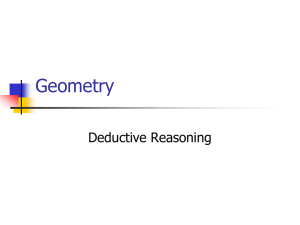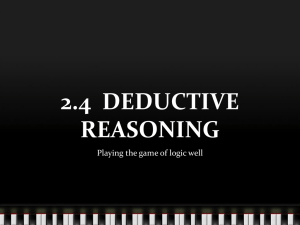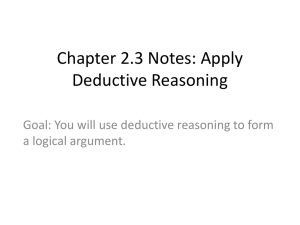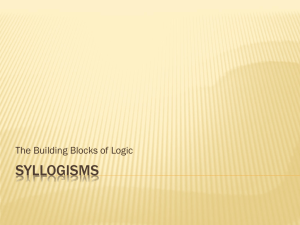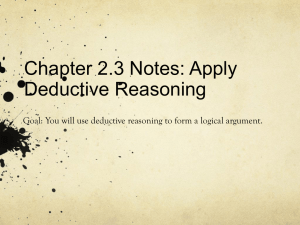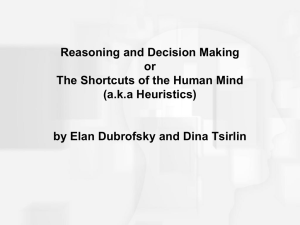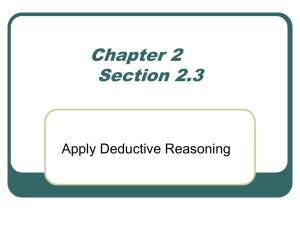Logic: evaluating deductive arguments - the syllogism
advertisement
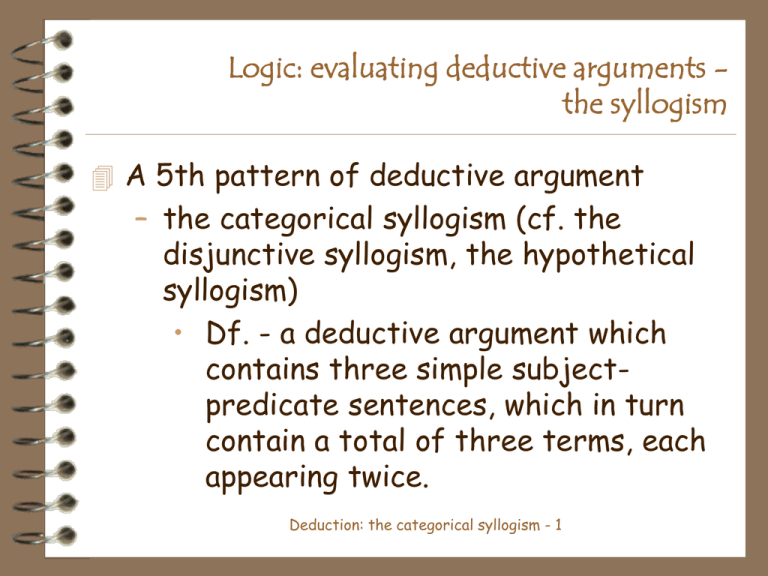
Logic: evaluating deductive arguments the syllogism A 5th pattern of deductive argument – the categorical syllogism (cf. the disjunctive syllogism, the hypothetical syllogism) • Df. - a deductive argument which contains three simple subjectpredicate sentences, which in turn contain a total of three terms, each appearing twice. Deduction: the categorical syllogism - 1 Logic: evaluating deductive arguments the syllogism • e.g. – All of Shakespeare’s dramas are in blank verse, and some of Shakespeare’s dramas are great plays. Hence some great plays are in blank verse. Deduction: the categorical syllogism - 2 Logic: evaluating deductive arguments the syllogism – The components of a categorical syllogism • the three terms – middle term - this is the basis of the logic of a syllogism – major term – minor term Deduction: the categorical syllogism - 3 Logic: evaluating deductive arguments the syllogism – Illustration: the Shakespeare example again • All S are B. • Some S are G. • Therefore, some G are B. Deduction: the categorical syllogism - 4 Logic: evaluating deductive arguments the syllogism – The 3 statements in a categorical syllogism • major premise • minor premise • conclusion Deduction: the categorical syllogism - 5 Logic: evaluating deductive arguments the syllogism – Testing validity • The need for rules rather relying on patterns – 256 patterns; 19 of these are valid – (Each of the 3 sentences in a syllogism can have 4 possible forms; this yields 64 possibilities. [4 x 4 x 4 = 64] And the middle term has 4 possible locations, thus 64 x 4 = 256.) Deduction: the categorical syllogism - 6 Logic: evaluating deductive arguments the syllogism – The four rules for testing the validity of the categorical syllogism • (1) In a valid cat. syllogism, the middle term must be distributed at least – Aside on the notion of distribution » Distribution - whether a term (not a statement) refers to all or some of the members of its class Deduction: the categorical syllogism - 7 Logic: evaluating deductive arguments the syllogism – e.g., All whales are mammals. » The subject is ? (U or D) » The predicate is ? (U or D) – e.g., No Hawaiians love winter. » The subject is ? (U or D) » The predicate is ? (U or D) Deduction: the categorical syllogism - 8 Logic: evaluating deductive arguments the syllogism – e.g., Some Hawaiians love the mainland. » The subject is ? (U or D) » The predicate is ? (U or D) – e.g., Some Hawaiians do not love the mainland. » The subject is ? (U or D) » The predicate is ? (U or D) Deduction: the categorical syllogism - 9 Logic: evaluating deductive arguments the syllogism – Notice this pattern. • Distribution subject universal (all, no) - distributed particular (some) - undistributed predicate affirmative undistributed negative distributed Deduction: the categorical syllogism - 10 Logic: evaluating deductive arguments the syllogism – Back to rule # 1 Some poisons have medicinal value. Some things which have medicinal value have negative side effects. Therefore, some poisons have negative side effects. Deduction: the categorical syllogism - 11 Logic: evaluating deductive arguments the syllogism – An Euler diagram of the preceding syllogism. – The syllogism is invalid; it violates rule # 1 Deduction: the categorical syllogism - 12 Logic: evaluating deductive arguments the syllogism • (2) A syllogism in which a term moves from undistributed in a premise to distributed in the conclusion is invalid. (In a valid syllogism, a term may not move from U in the premises to D in the conclusion.) Deduction: the categorical syllogism - 13 Logic: evaluating deductive arguments the syllogism – – – – U in premise D in conclusion - invalid U in premise U in conclusion - valid D in premise D in conclusion - valid D in premise U in conclusion - valid • Reason why U to D is invalid: the conclusion goes beyond the evidence provided in the premises. This is okay in inductive arguments, but not in deductive. Deduction: the categorical syllogism - 14 Logic: evaluating deductive arguments the syllogism – E.g., All Nazis are guilty persons. Some anti-semites are not Nazis. Some anti-semites are not guilty persons. Deduction: the categorical syllogism - 15 Logic: evaluating deductive arguments the syllogism • (3) A valid cat. syllogism may not have two negative premises. (A cat. syllogism with two negative premises is invalid.) • e.g., No members of the Kiwanis like Sting. No Democrats are members of the Kiwanis. Thus no Democrats like Sting. Deduction: the categorical syllogism - 16 Logic: evaluating deductive arguments the syllogism » Deduction: the categorical syllogism - 17 Logic: evaluating deductive arguments the syllogism • (4) In a valid cat. syllogism, if a premise is negative, the conclusion must be negative, & if the conclusion is negative, one premise must be negative. – e.g., Some physicians are members of the AMA. No members of the AMA are for National Health Insurance. Hence some physicians are for National Health Insurance. Deduction: the categorical syllogism - 18 Logic: evaluating deductive arguments the syllogism – Deduction: the categorical syllogism - 19 Logic: evaluating deductive arguments the syllogism • FINIS the categorical syllogism – To inductive logic Deduction: the categorical syllogism - 20
